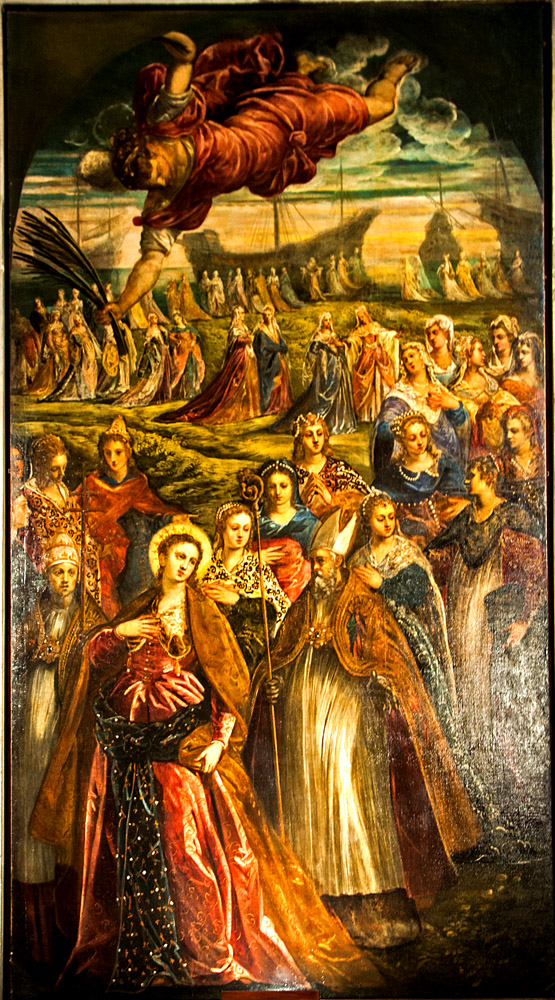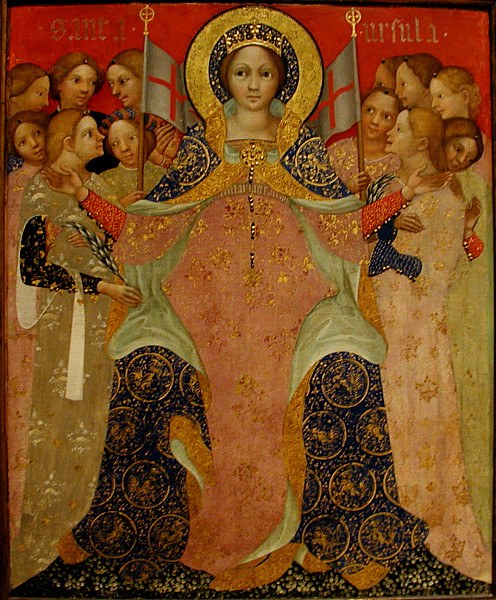The story originated in a local tradition in Cologne that some number of Christian virgins had been martyred by the Romans in the early years of the city. The earliest testimony to these virgins is a stone inscription from the fourth century, now in the choir of the Church of St. Ursula in Cologne. It speaks only of an unspecified number of virgin martyrs "from the East." But in the ninth century a number of liturgical sources mention these Colognese virgins, reporting their number variously as five, eight, or eleven. Scholars are uncertain as to how the number eleven was chosen and then multiplied by a thousand.1
Medieval portraits of St. Ursula are often found among other saints in altarpieces (example) and predellas (example). In the Golden Legend her companions were beheaded but she was shot with an arrow by the Hun prince, whom she had spurned. The second picture at right therefore uses an arrow as her attribute and adds a banner with the cross of St. George, the patron saint of England. The banner is very common in her portraits, the arrow less so. As a princess, she is often pictured with a crown, as in the third picture at right.
Prepared in 2015 by Richard Stracke, Emeritus Professor of English, Augusta University

Tintoretto's painting of Ursula's journey to Cologne with Ciriacus and the 11,000 virgins. (See description page.)

Allegreto Nuzi, St. Ursula, 1365 (See description page)

Niccolò di Pietro, 14th/15th century (See description page)
ATTRIBUTES
- Banner of St. George
- Arrow
- Crown
MORE IMAGES
- 1330: Daddi, The Arrival of St. Ursula at Cologne.
- 1529: In Cornelis Engebrechtsz's triptych of the Adoration of the Magi St. Ursula is pictured on the right wing holding the arrow that is one of her attributes.
DATES
- Feast day: October 21 (suppressed in 1969)
- The Legend says that some date the martyrdom of Ursula and the virgins to 238 but that the year 452 is more likely.
BIOGRAPHY
- Golden Legend #158: html or pdf
- Roman Breviary (1908 English translation), IV, 667-68
- Acta Sanctorum, October vol. 9, 73-303
- "Historia SS. Ursulae et Sociarum Eius" in Analecta Bollandiana, III, 5-20
- In 1136 Geoffrey of Monmouth included in his History of the Kings of Britain (V, 15-16) a rather different version of Ursula's legend in which she and the virgins leave Britain not on pilgrimage but to be married to the soldiers of the ruler of Brittany.
RECOMMENDED
- C. Cusack, "Hagiography and History: the Legend of Saint Ursula". (Explains the legend's historical details and especially its relation to medieval interests.)